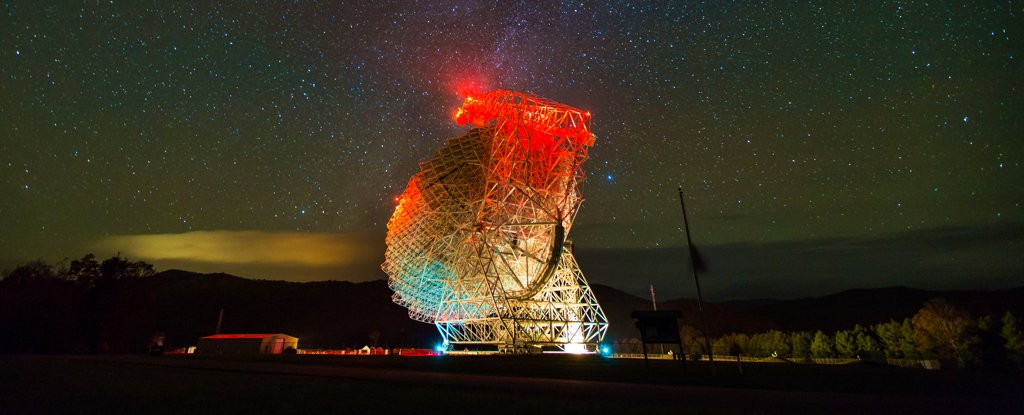
In 2017, astronomers captured a mysterious signal from deep space. For mere milliseconds, it flared brightly in the radio spectrum and fell away, and that seemed to be that. But it wasn't.
Follow-up observations have now revealed the signal repeating, nearly 600 times fainter than that first burst. The repetition suggests these weird radio flares we keep detecting from the cosmos could be more active and more complex than we ever knew.
The flares are called fast radio bursts (FRBs), one of the most bewildering phenomena from deep space. They show up in radio data, huge spikes of electromagnetic energy, as powerful as hundreds of millions of Suns, in a burst only milliseconds in duration.
We don't yet know what causes them, or even where most of them come from; of the over 150 bursts detected, only a handful have been traced back to their galaxies of origin.
Not all FRBs are the same, either. There are differences such as the strength of the signal, the way the signal is twisted (polarisation), tiny differences in duration. But one of the biggest differences is whether the signal repeats. Some do. Most do not.
Or, at least, have not been detected to do so.
"One of the big open questions about FRBs is whether or not they all repeat. While over a hundred FRBs are known, up until recently only one had been found to repeat," astronomer Pravir Kumar of Swinburne University of Technology in Australia told ScienceAlert.
To find FRBs and search for their repetitions, Kumar and colleagues had been using the Australian Square Kilometre Array Pathfinder (ASKAP) in Australia.
"We found 20 FRBs and searched for repetitions with ASKAP for two years," he said. "In over 12,000 hours we found none! However, could it be possible that repetitions were too faint for ASKAP to detect?"
The focus of the study was a particularly bright single burst called FRB 171019. Although it had not been traced to a point of origin, the patch of sky that belched it out was known; so Kumar and his colleagues scored some observing time on some of the world's most powerful radio telescopes to conduct follow-up observations.
Having found nothing with ASKAP, now the researchers pointed the Green Bank Telescope in the US and the Parkes Observatory radio telescope in Australia at that patch of sky.
The Parkes Observatory also found nothing. But in the data from the Green Bank Telescope, two faint signals emerged.
"When I first saw the FRB signal on my computer screen, I just could not believe it," Kumar told ScienceAlert. "It was indeed a very exciting moment!"
In August of last year, after Kumar's team had made their detection and were preparing their paper, the CHIME collaboration in Canada - an experiment scanning a lower range of frequencies than telescopes like ASKAP, and which published a haul of eight repeaters last year - detected a third repeat signal from FRB 171019.
These findings increase the total number of known repeating fast radio bursts, and hint that some of the many other single bursts detected so far could also be bursting repeatedly, out of the detection range of the instruments that have been used to follow them up.
But, Kumar said, the FRB 171019 repeat signals are remarkable because they are so incredibly faint - around 590 times fainter than the burst detected by ASKAP. That's the largest difference in energy emission yet detected in a repeating fast radio burst.
We still can't tell what caused it, of course. A study last year found a similarity with magnetar outbursts, with one major problem: FRB sources would be 100 billion times more luminous than a magnetar.
A "major problem" of similar ilk seems to accompany every explanation put forward so far; FRBs are very good at evading easy answers. But the new repeat bursts could be inching us closer.
"The wide range of luminosity observed in this burst source provides significant constraints for various models of burst emission," Kumar noted.
"This discovery has moved us one step closer to understand the relationship between repeating and one-off bursts. We have shown that at least some bright FRB sources have faint repetitions and may be found to repeat if we follow-up with more sensitive telescopes."
So, that's what Kumar and colleagues will be doing. With the Green Bank Telescope, and the new ultra-wide-bandwidth receiver on the Parkes Observatory, the researchers will take observations of other single bursts to see if they can detect faint repeats.
And we haven't heard the last of FRB 171019, either.
"The fact that the [FRB 171019] source repeats gives us an excellent opportunity to pinpoint it with a radio interferometer," Kumar told ScienceAlert.
"The challenge is that the repeats are very faint, so we need to use the most sensitive interferometer. We were fortunate to have been awarded time to follow up the source with the Very Large Array later this year, so stay tuned."
The research has been published in The Astrophysical Journal Letters.
"fast" - Google News
February 06, 2020 at 11:59AM
https://ift.tt/2Utc54B
Mysterious Signals Hint That Fast Radio Bursts Are More Active Than We Thought - ScienceAlert
"fast" - Google News
https://ift.tt/2VRmxBz
Shoes Man Tutorial
Pos News Update
Meme Update
Korean Entertainment News
Japan News Update
No comments:
Post a Comment